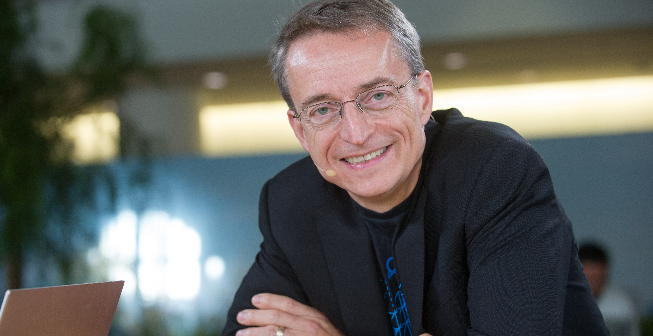 INFRA
INFRA
 INFRA
INFRA
 INFRA
INFRA
Chipmaker Intel Corp. posted the biggest quarterly loss in its history today and said it expects to remain in the red in the coming quarter, amid a sharp decline in personal computer sales that has seriously dented its business.
The company reported a first-quarter net loss of $2.8 billion, or 66 cents a share, reversing an $8.1 billion or $1.98-a-share profit a year ago. Revenue for the period plunged 36% from a year ago, to $11.7 billion.
Still, the company can be pleased that it actually did better than expected. Wall Street analysts were expecting much worse, having forecast a loss of 15 cents per share on sales of just $11.04 billion.
The results mean Intel’s run of declining revenue now stretches to five consecutive quarters, but there is hope that the company might have hit the bottom. For the second quarter, Intel said, it expects revenue to pick up slightly. It’s forecasting sales of $12 billion and a loss of four cents per share. Wall Street is looking for revenue of $11.75 billion and a loss of just a penny per share.
The forecast of a slight uptick in revenue appears to have driven some optimism among Intel’s investors, as the company’s stock rose 5% in extended trading, adding to a gain of almost 3% in the regular session when many tech stocks rose.
Intel Chief Executive Pat Gelsinger (pictured), who is now entering his third year at the helm of the company, said it is making “steady progress” on its transformation. “We hit key execution milestones in our data center roadmap and demonstrated the health of the process technology underpinning it,” he said. “While we remain cautious on the macroeconomic outlook, we are focused on what we can control as we deliver on IDM 2.0: driving consistent execution across process and product roadmaps and advancing our foundry business to best position us to capitalize on the $1 trillion market opportunity ahead.”
Gelsinger’s transformation plan calls for Intel to open up its factories as foundries that will mass produce computer chips for other companies. He hopes that it will soon be able to manufacture chips as advanced as those made by Taiwan Semiconductor Manufacturing Co. If it can, it will be in a better position to compete for custom work such as the A-Series chips that power Apple Inc.’s iPhones. According to Gelsinger, the company remains on track to get there by 2026.
Progress is being made on the foundry plan. During the recent quarter, Intel announced a partnership with British chip designer Arm Ltd. to enable semiconductor firms to build low-power systems-on-chip on its cutting-edge manufacturing process.
“We still have more work to do as we reestablish process, product, and cost leadership, but we continue to provide proof points each quarter,” Gelsinger told analysts on a conference call.
Patrick Moorhead of Moor Insights & Strategy told SiliconANGLE that Intel is in the middle of a complex turnaround that involves a complete rebuilding of its design and manufacturing processes and technology, all at the same time. “Pat Gelsinger has three years left in its commitments,” he said. “I think the company has a positive future as long as it sticks to its ‘five nodes in four years’ commitment and if it can build the appropriate AI software ecosystem.”
All well and good, but in the meantime Intel is struggling with much lower demand for its products. During the first quarter, global shipments of personal computers fell by about 30%, according to a report from International Data Corp., and that had a direct impact on Intel’s bottom line.
The Client Computing group, Intel’s biggest money maker, responsible for producing chips for PCs, laptops and notebooks, saw revenue fall by 38% to just $5.8 billion. Gelsinger signaled that the PC market might be on the verge of a recovery, however. “We are seeing increasing stability in the PC market with inventory corrections largely proceeding as we had expected,” he said.
In recent quarters, Intel has been saved by a growing Data Center and AI segment that makes chips for the servers that power corporate and cloud data centers. However, this time the unit saw sales tumble by 39%, with revenue falling to just $3.7 billion. Gelsinger conceded that the server and networking markets have yet to bottom out as cloud and enterprise demand remains weak, so there could be worse to come.
Intel’s Network and Edge business also suffered, with revenue falling 30% to just $1.5 billion. The only real bright spot was Mobileye, a subsidiary that went public last year but remains under Intel’s control. Mobileye makes chips and software for self-driving vehicles and it delivered sales growth of 16%, to $458 million.
“One year ago Intel delivered $18 billion-plus in revenue and a profit of more than $8 billion,” said Holger Mueller of Constellation Research Inc. “Today, its revenue is down to $11.7 billion and it has racked up billions in losses. Things won’t get better anytime soon either, as the company is forecasting yet another loss. The expense cuts will help, but not by much. Pat Gelsinger has his work cut out.”
In an update on Intel’s cost-cutting measures, including recent layoffs and pay cuts for senior executives, Gelsinger said the company expects to save about $3 billion in fiscal 2023, rising to as much as $10 billion by 2025.
Investors may also have been pleased to see Intel’s gross margins expand. The company said its gross margin will grow to around 37.5% in the current quarter, ahead of analysts’ estimates. According to Intel Chief Financial Officer David Zinsner, that’s a sign of better cost control and operating efficiency.
“Maybe the best way to describe it is I think for the back half of the year, we feel like we’ll be comfortably in the 40s from a gross margin perspective,” he said.
THANK YOU